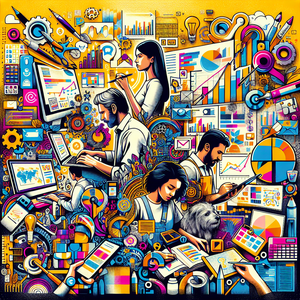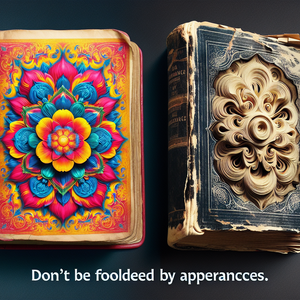
Navigating 15 Exciting Graphic Design Careers and Their Influence on Digital Marketing
In today’s fast-paced digital world, the demand for proficient graphic design professionals is greater than ever. As brands intensify their focus on visual identity and audience connection, job seekers find themselves in a thriving job market filled with diverse opportunities. Tools like Canva have made design accessible, enabling individuals, even those without formal training, to create stunning visuals for social media, presentations, and beyond. However, the range of roles available—from graphic designers to digital marketing experts—underscores the varied skill sets needed in this field. This article explores 15 intriguing positions within graphic design and digital media, detailing their responsibilities, qualifications, and the crucial roles they play in effective visual communication and brand success.
Job Summaries:
Graphic Designer:
- Graphic designers are the visual storytellers of the digital age.
- Crafting eye-catching designs for websites, advertisements, and social media platforms.
- Utilizing software like Adobe Creative Suite and Canva.
- They turn ideas into visual narratives.
- A bachelor’s degree in graphic design or a related field is usually required.
- Complemented by a compelling portfolio.
- Their contributions are essential for establishing brand identities.
- Enhancing user experiences, making them indispensable to marketing teams.
UI/UX Designer:
- Focusing on user interface and experience, UI/UX designers create designs that foster user engagement.
- They conduct research, design wireframes, and test usability to refine interfaces.
- Mastery of tools such as Figma or Sketch and insights into user psychology are vital.
- While a design degree is beneficial, practical experience demonstrated through a strong portfolio can suffice.
- Their work ensures that digital products resonate with users aesthetically and functionally.
Social Media Manager:
- Social media managers are tasked with curating and generating content across various platforms to amplify a brand’s online presence.
- They develop content strategies, design graphics using tools like Canva, and analyze engagement metrics for optimization.
- Strong communication skills and an awareness of social media trends are critical.
- Though a degree in marketing or communications is advantageous, hands-on experience and a portfolio showcasing successful campaigns often matter more.
- This role directly influences brand visibility in today’s digital landscape.
Content Creator:
- Content creators are responsible for producing engaging multimedia content tailored to specific audiences.
- Their work includes brainstorming, designing visuals, shooting videos, and editing materials for quality and relevance.
- Familiarity with design and editing software is essential.
- While a background in communications, marketing, or journalism is preferred, creativity and a robust portfolio can make candidates stand out.
- They are integral to building brand narratives and fostering community engagement.
Digital Marketing Specialist:
- Digital marketing specialists devise and implement online strategies aimed at increasing traffic and sales.
- They assess data to gauge campaign effectiveness and work alongside graphic designers to create compelling marketing materials.
- Proficiency in SEO, Google Analytics, and social media marketing tools is crucial, along with strong analytical capabilities.
- A degree in marketing or business is commonly required.
- This role is vital for brands looking to strengthen their digital presence and connect with their target audience.
Brand Strategist:
- Brand strategists are responsible for crafting and managing a brand's identity and message, ensuring consistency across all platforms.
- They perform market research, analyze competitors, and collaborate with designers to create visual assets that reflect brand values.
- A bachelor’s degree in marketing or communications is typically necessary, along with strong analytical and communication skills.
- This role is instrumental in shaping how brands are perceived in the marketplace.
Video Editor:
- Video editors play a crucial role in post-production, transforming raw footage into polished content.
- They work with audio and graphics, often using software like Adobe Premiere and Canva for enhancements.
- While a degree in film or media production is useful, a strong portfolio can be equally influential.
- This position is essential for crafting engaging visual content, directly linking to successful digital marketing initiatives.
Illustrator:
- Illustrators bring original artwork to life across various media, including books, magazines, and digital platforms.
- Using both traditional and digital methods, they collaborate with writers and designers to create compelling visuals.
- A degree in fine arts or illustration is commonly required, along with a diverse portfolio showcasing various styles.
- Their artistry enhances visual storytelling, adding emotional depth and richness to narratives.
Web Designer:
- Web designers focus on creating and maintaining visually appealing and user-friendly websites.
- They employ design software and coding languages like HTML and CSS to develop functional layouts.
- A degree in web design or a related discipline is often preferred, though a strong portfolio can also demonstrate capability.
- This role is critical for ensuring websites attract and retain visitors.
Product Designer:
- Product designers innovate and design new products, balancing functionality with aesthetics.
- They conduct market research, create prototypes, and collaborate with marketing teams to meet consumer needs.
- A degree in industrial design or a related field is typically required, along with problem-solving skills and a comprehensive portfolio.
- This role is essential for bringing innovative ideas to market, ensuring products are visually appealing and user-friendly.
Marketing Coordinator:
- Marketing coordinators facilitate marketing campaigns by bridging communication between departments.
- They assist in designing promotional materials, managing social media accounts, and conducting market research.
- A degree in marketing or communications is often preferred, paired with strong organizational and communication skills.
- This role is crucial for maintaining brand consistency in marketing endeavors.
Creative Director:
- Creative directors oversee the entire creative process, guiding design teams to uphold a cohesive vision.
- They collaborate with clients to grasp their needs, providing artistic direction throughout project lifecycles.
- A solid background in graphic design and leadership experience is typically required, along with a strong portfolio.
- This role is vital for ensuring that all creative outputs align with the brand’s identity and objectives.
Art Director:
- Art directors manage the visual aspects of projects by directing designers, illustrators, and photographers to ensure quality and consistency.
- They develop the overall visual style in collaboration with clients and creative teams.
- A degree in art or design is generally required, along with substantial industry experience.
- This role is critical for maintaining high standards in creative output.
Packaging Designer:
- Packaging designers create product packaging that merges aesthetics with functionality.
- They consider materials, branding, and user experience while ensuring compliance with industry regulations.
- A degree in graphic design or industrial design is often required, alongside strong creative and technical skills.
- This role is essential for attracting consumers and enhancing product appeal.
Event Designer:
- Event designers conceptualize and execute the visual aspects of various events, from corporate gatherings to weddings.
- They collaborate with clients to understand their vision, creating layouts, decor, and promotional materials.
- Strong organizational and creative skills are imperative, and a background in design or event planning is often helpful.
- This role ensures that events are visually striking and align with the client’s brand or theme.
The diversity of roles within graphic design and digital communication reveals the myriad opportunities available in this field, each contributing significantly to branding and marketing success. Aspiring professionals can gain valuable insights into the skills and experience needed by exploring current job openings. As the demand for innovative design continues to grow, the potential for career advancement in these areas remains bright and full of promise. By emphasizing the roles' direct impact on digital marketing strategies, this article underscores the essential nature of graphic design in the contemporary business landscape.
Explore More Jobs

